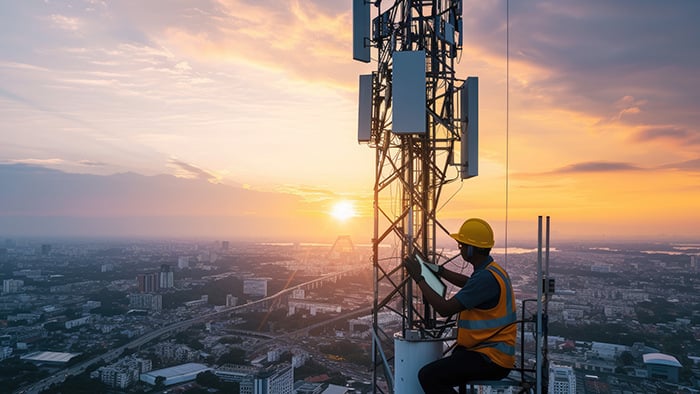What is a smart home?
To define a smart home is simple: it’s a home equipped with lighting, heating, and electronic devices that can be controlled remotely by a phone or computer. But like most things in life, the actual smart home concept isn’t quite so simple.
For example, one of the key features of a smart home is that it’s connected to the internet. However advanced your thermostat or doorbell or gaming system might be, if they’re not able to go online, they don’t really make your home “smart”. Likewise, remotely controlled features in your home are nothing new — garage door openers have been around since 1926 — but the control has to be based on the internet (rather than bluetooth or other airborne signals) to be “smart”.
And it doesn’t matter how advanced your router is or how many computers, gaming consoles, or mobile devices you have — it’s not technically a smart home unless you can control or automate the functions of your home with the technology. That could be something as simple as having your blinds go down automatically to keep the sun out of your living room, to as complex as a surround-sound system that follows you as you move throughout your home.
That being said, most homes these days are packed with connected devices, so whether or not you automate your home functions with smart technology, you’ll want the same advanced level of security to stay safe from cybersecurity threats. Avast One offers comprehensive protection to help secure your home network and keep your communications private.
Want to check if you have a smart home? If you can go on your phone and see how warm it is in your home, turn devices on or off, activate security, or check a security camera… then congratulations! You’re living in a smart home.
What is smart home technology?
Smart home tech is based on the IoT (Internet of Things): the principle of bringing internet connectivity to everyday objects. Whereas historically, the internet was designed to be used primarily by computers, we’ve been able to apply it to countless other things, such as phones, cars, medical devices, and of course, connected homes.
The components of a smart home are fairly straightforward. First, you need a router, which acts as the nexus through which all your other connected devices can communicate with each other, as well as with more remote devices, like your phone or PC. Then, all you need are smart devices — even just one — that connects to the router and can be controlled remotely. Once you have it set up, then you’ve officially upgraded your home to a smart home. That’s all it takes!
How does the technology itself work?
Similar to PCs and mobiles, smart devices send out wireless signals — specifically, radio waves called ZigBee and Z-Wave, or X10 signals for older devices — in order to connect to the router, and the internet at large. Both ZigBee and Z-wave signals are designed to find the shortest possible path to their destination, which is important to make sure the connection is strong and reliable. They also find that route differently, which can help prevent interference.
Your devices might also use something called Insteon, which allows devices to communicate over either radio waves or electric wires. So if one communication path isn’t working, the device can switch to the other to see if that one works.
But of course, sending out a signal is only the first step — there needs to be something to pick it up, too. A router receives the signal, and then sends the information either to an external website, to your smartphone, or to another device that’s ready to receive the signal and respond to a command. That last category includes the actual lights you’re turning on or off, the heating or cooling systems you’re controlling via your thermostat, the doors you’re locking or unlocking, and so on.
So really, there’s nothing that special or different about how this technology works— but it sure is nifty!
How to make a smart home system
Wondering how to set up a smart home system? All you need to make your home a smart home is a single smart home device, a Wi-Fi network to connect it to, and a mobile device that lets you monitor and control it from anywhere via a dedicated app — it’s that simple.
But, if you’ve got all the must-have smart home devices, including a smart fridge, thermostat, security cameras, speakers, and lightbulbs, it’s best to link all your smart home features via a centralized, hub device. This lets all your smart devices communicate with each other, and allows you to control them all through a single app on your smartphone or tablet.
Benefits of smart homes
Why live in a smart home? There are lots of benefits to making your home connected.
-
 Full control over your devices: Ever leave home and worry you left something turned on? Or want to turn the heat on while driving home on a cold winter day? Unlock the door remotely for your spouse or kid? A smart home lets you command your home even when you’re far away.
Full control over your devices: Ever leave home and worry you left something turned on? Or want to turn the heat on while driving home on a cold winter day? Unlock the door remotely for your spouse or kid? A smart home lets you command your home even when you’re far away.
-
 Comfort: A smart home can be very cozy — not only can you remotely control its functions without leaving your favorite chair, you can also automate some routine housekeeping chores, like vacuuming.
Comfort: A smart home can be very cozy — not only can you remotely control its functions without leaving your favorite chair, you can also automate some routine housekeeping chores, like vacuuming.
-
 Accessibility: For the differently abled, a smart home could make a world of difference, giving them the ability to live more independently than ever before.
Accessibility: For the differently abled, a smart home could make a world of difference, giving them the ability to live more independently than ever before.
-
 Physical security: Almost all home security systems are connected to the internet, and for good reason — they’ll let you lock your doors remotely, check any cameras in real-time, and they’ll notify you and the police automatically if something goes awry.
Physical security: Almost all home security systems are connected to the internet, and for good reason — they’ll let you lock your doors remotely, check any cameras in real-time, and they’ll notify you and the police automatically if something goes awry.
-
 Save money: While the cost of making a home smart can be pretty significant, once the systems are set up, you can easily track your energy and water usage, heat and light only specific rooms, and control energy output to other devices.
Save money: While the cost of making a home smart can be pretty significant, once the systems are set up, you can easily track your energy and water usage, heat and light only specific rooms, and control energy output to other devices.
-
 Preparing for the future: More and more homes are becoming smart, and soon, it will be the expected default. Connecting your home now makes it ready for the future… and certainly raises its value on the market.
Preparing for the future: More and more homes are becoming smart, and soon, it will be the expected default. Connecting your home now makes it ready for the future… and certainly raises its value on the market.
-
 Bragging rights: Let’s be honest — we all want to impress our friends and family, and a cool sci-fi house is just the way to do it. Hope you like having guests over!
Bragging rights: Let’s be honest — we all want to impress our friends and family, and a cool sci-fi house is just the way to do it. Hope you like having guests over!
Problems with smart homes
Nothing is entirely good — and that includes, sadly, smart homes.
-
 More vulnerabilities: From a cybersecurity perspective, having one weak device means all of them are vulnerable — including your PC, phone, or other device with sensitive information stashed on it. Smart devices are often less secure than computers and phones, making them more vulnerable to malware or getting hacked and included in a botnet, then used in a DDoS attack.
More vulnerabilities: From a cybersecurity perspective, having one weak device means all of them are vulnerable — including your PC, phone, or other device with sensitive information stashed on it. Smart devices are often less secure than computers and phones, making them more vulnerable to malware or getting hacked and included in a botnet, then used in a DDoS attack.
-
 Energy-dependant: Most essential smart devices can be used manually too, so you don’t ever have to worry about being locked out of your home because the power goes out. But if the internet, or your power, should ever go out, some devices might turn into little more than expensive paperweights.
Energy-dependant: Most essential smart devices can be used manually too, so you don’t ever have to worry about being locked out of your home because the power goes out. But if the internet, or your power, should ever go out, some devices might turn into little more than expensive paperweights.
-
 Crowded network: Your smart home can only be as robust as your network can handle. If too many devices are hogging the wireless, they will considerably slow down the internet for other devices (like smart TVs, laptops, and tablets). This is especially problematic in the United States, where networks are, on average, slower and more expensive.
Crowded network: Your smart home can only be as robust as your network can handle. If too many devices are hogging the wireless, they will considerably slow down the internet for other devices (like smart TVs, laptops, and tablets). This is especially problematic in the United States, where networks are, on average, slower and more expensive.
-
 More accounts: Many of your devices, particularly ones that have their own webpages or apps, will require you to have an account to use them. And the more accounts you have, the more vulnerable you are to having personal information exposed in a data breach — especially if you share a password across multiple accounts (which you really shouldn’t do!).
More accounts: Many of your devices, particularly ones that have their own webpages or apps, will require you to have an account to use them. And the more accounts you have, the more vulnerable you are to having personal information exposed in a data breach — especially if you share a password across multiple accounts (which you really shouldn’t do!).
-
 It’s expensive: It’s estimated that building a smart home from scratch can cost an extra $10,000 to $250,000, depending on what kind of technology you want. That’s some serious dough to fork over for some mild convenience. Fortunately, existing homes can be upgraded with some very simple smart home technologies for way, way less.
It’s expensive: It’s estimated that building a smart home from scratch can cost an extra $10,000 to $250,000, depending on what kind of technology you want. That’s some serious dough to fork over for some mild convenience. Fortunately, existing homes can be upgraded with some very simple smart home technologies for way, way less.
But while smart homes might have their share of problems, you shouldn’t have to worry about securing the devices connected to your home network. Avast One offers a suite of security and privacy features — like an ironclad firewall, ransomware protection, a VPN, anti-tracking safeguards, and more — to ensure your home network stays safe from hackers, malware, and other online threats.














